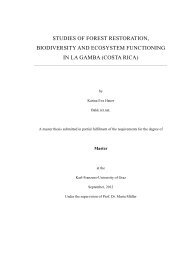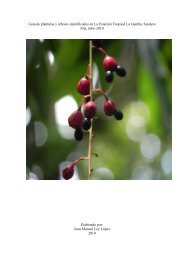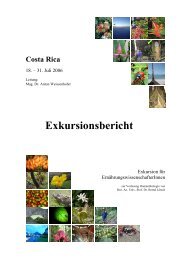Leaf colour patterns, vegetative and sexual reproduction of Episcia ...
Leaf colour patterns, vegetative and sexual reproduction of Episcia ...
Leaf colour patterns, vegetative and sexual reproduction of Episcia ...
You also want an ePaper? Increase the reach of your titles
YUMPU automatically turns print PDFs into web optimized ePapers that Google loves.
<strong>and</strong> the measurements were compared to each other. The number <strong>of</strong> leaves as well as the<br />
presence <strong>of</strong> roots <strong>and</strong> the development <strong>of</strong> further stolons was documented.<br />
Results: Stolons are preferentially developed in the leaf axils <strong>of</strong> the lower nodes. Early in the<br />
development, the first two leaves <strong>of</strong> the stolon are visible. The stolon begins to grow in length<br />
rapidly. The first pair <strong>of</strong> leaves are cataphylls. After they have reached a certain size (about 1 cm x<br />
1 cm) a second pair <strong>of</strong> leaves becomes visible. At that moment the stolon has reached a couple <strong>of</strong><br />
centimeters in length <strong>and</strong> continues to grow very fast. The daily increase in length averages 6.5<br />
mm. Before the development <strong>of</strong> the first roots at the first node begins, another pair <strong>of</strong> leaves<br />
becomes visible. The first roots do not immediately anchor in the ground. In this stage the stem<br />
(connection to the original plant) has a length <strong>of</strong> over 10 cm (15 cm not rarely seen). Further on,<br />
roots are developed at the second node. They afterwards anchor in the ground. The growth in<br />
length has stopped. The growth is now restricted to the area above the first node. After rooting<br />
the shoot apex begins to rise. The connection to the original plant exists for a long time. After<br />
weeks, this connection begins to whither <strong>and</strong> finally drops. At this point the stolon has developed<br />
more than four pairs <strong>of</strong> leaves.<br />
Discussion: Among the gesneriads stolon spreading can be noticed in a few species, for<br />
instance, Henckelia stolonifera, Boeica stolonifera, Chirita stolonifera. The genus Alsobia, which is<br />
systemically close to <strong>Episcia</strong>, develops stolons too. The genus <strong>Episcia</strong> differs ins<strong>of</strong>ar as two stolons<br />
per node regularly develop.<br />
Most herbs inhabiting shaded forest understorey have some ways <strong>of</strong> clonal growth (Doust<br />
<strong>and</strong> Doust 1988). The development <strong>of</strong> stolons enables the plants to exploit an optimal<br />
environment, meaning to use advantageous living conditions, more effectively. If enough<br />
resources are present, these can be quicker made accessible by stolon propagation than by <strong>sexual</strong><br />
<strong>reproduction</strong> (Fenner <strong>and</strong> Thompson 2005). In addition, the survivorship <strong>of</strong> stolons is relatively<br />
higher in comparison with seedlings (Sarukhán <strong>and</strong> Harper 1973).<br />
The mother plant has no need to put its energy in the development <strong>of</strong> flowers <strong>and</strong>, later on,<br />
<strong>of</strong> fruits. It is much more independent from pollinators <strong>and</strong> dispersal. The energy is invested in a<br />
new plant <strong>and</strong> thus it is not “wasted” by unsuccessful pollination or failed development <strong>of</strong> fruit<br />
(Fenner <strong>and</strong> Thompson 2005).<br />
Indeed, there are some drawbacks connected with <strong>vegetative</strong> propagation. No spreading over<br />
a wider area is possible (10 to 15 cm at the maximum). The possibility to occupy habitats that are<br />
further away is solely opened up by dispersal <strong>of</strong> seeds. The vector <strong>of</strong> seeds <strong>of</strong> <strong>Episcia</strong> lilacina is still<br />
unknown at the moment. If dispersal does not take place by vectors but by just opening the seed<br />
22
















